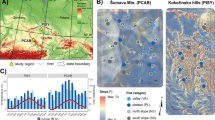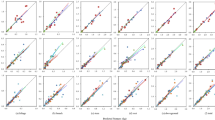Abstract
The aim of this study was to relate tree planting spatial arrangements of five eucalypt clones in silvopastoral systems to brachiaria production. Tree layouts were (2 × 2) + 10 m and (3 × 3) + 9 m (double-rows) and 9 × 3 m (single-row) planting arrangements. Tree leaf area index (LAI) was measured acrosss the interrow at 38, 50, and 62 months after planting. Tree crown radius was measured at 45° intervals around the stem at 38 months. Brachiaria was sampled across the interrow at 50 months. The LAI decreased with tree density for most clones and ages. The clones GG100, 58, and 62 presented the lowest LAI, independently of age and planting arrangements. LAI decreased from the tree row to the middle of the interrow, mainly for the double-row arrangements. There was positive correlation between crown radius and area per tree, except for the clone 02, and negative with LAI for the clone 19. The highest brachiaria production was obtained in the arrangements 9 × 3 m (clones GG100 and 62) and (3 × 3) + 9 m (clone 62). Brachiaria production varied across the interrow for clone 58 in the (2 × 2) + 10 m arrangement and for the clone 62 in the double-row arrangements. LAI was not significantly correlated with brachiaria production for the tree planting spatial arrangements and the genotypes studied. Further studies should include larger distances between hedgerows to allow greater resources availability differences across the interrow.


Similar content being viewed by others
References
Alvares CA et al (2013) Köppen’s climate classification map for Brazil. Meteorol Z. doi:10.1127/0941-2948/2013/0507
Álvarez J et al (2013) Factors influencing the growth of radiata pine plantations in Chile. Forestry 86:13–26
Alves FF (2011) Seca de ponteiros e crescimento de clones de eucalipto em diferentes doses de adubação. Dissertation Universidade Federal de Viçosa, Viçosa
Andrade CMS et al (2001a) Fatores limitantes ao crescimento do capim-tanzânia em um sistema agrossilvipastoril com eucalipto, na região dos cerrados de Minas Gerais. Rev Bras Zootec 30:1178–1185
Andrade CMS et al (2001b) Transmissão de luz em sistemas silvipastoris com eucalipto. Rev Árvore 26:19–23
Andrade CMS et al (2004) Crescimento de gramíneas e leguminosas forrageiras tropicais sob sombreamento. Pesq Agropec Bras 39:263–270
Burner DM, Brauer DK (2003) Herbage response to spacing of loblolly pine trees in a minimal management silvopasture in southeastern USA. Agrofor Syst 57:69–77
Cacau FV et al (2008) Decepa de plantas jovens de eucalipto e manejo de brotações, em um sistema agroforestal. Pesq Agropec Bras 43:1457–1465
Castro CRT et al (2009) Características agronômicas, massa de forragem e valor nutritivo de Brachiaria decumbens em sistema silvipastoril. Pesq Florest Bras 60:19–25
Chaves RA et al (2007) Dinâmica de cobertura de dossel de povoamentos de clones de Eucalyptus grandis W. Hill ex-Maiden submetidos a desrama artificial e desbaste. Rev Árvore 31:989–998
Devkota NR et al (2009) Relationship between tree canopy height and the production of pasture species in a silvopastoral system based on alder trees. Agrofor Syst 76:363–374
Dovey SB, Toit B (2006) Calibration of LAI-2000 canopy analyser with leaf area index in a young eucalypt stand. Trees 20:273–277
Dubè F et al (2002) A simulation model for evaluating technical and economic aspects of an industrial Eucalyptus-based agroforestry system in Minas Gerais, Brazil. Agrofor Syst 55:73–80
Embrapa—Centro Nacional de Pesquisa de Solos (2006) Sistema Brasileiro de Classificação de Solos, 2nd edn. Embrapa Solos, Rio de Janeiro
Fassbender HW (1984) Bases edafológicas de los sistemas de producción agroforestales. CATIE, Turrialba
Ferreiro-Domínguez N, Rigueiro-Rodríguez A, Mosquera-Losada MR (2011) Response to sewage sludge fertilisation in a Quercus rubra L. silvopastoral system: soil, plant biodiversity and tree and pasture production. Agric Ecosyst Environ 141:49–57
Flores FJ et al (2006) Using multispectral satellite imagery to estimate leaf area and response to silvicultural treatments in loblolly pine stands. Can J For Res 36:1587–1596
Fontan ICI (2007) Dinâmica de copa e crescimento de clones de eucalipto submetidos a desrama, em sistema agroflorestal. Dissertation Universidade Federal de Viçosa, Viçosa
Fontan ICI et al (2011) Growth of pruned eucalypt clone in an agroforestry system in Southeastern Brazil. Agrofor Syst 83:121–131
Forrester DI et al (2010) Growth and physiological responses to silviculture for producing solid-wood products from Eucalyptus plantations: an Australian perspective. For Ecol Manag 15:1819–1835
Freitas ECS et al (2013) Deposição de serapilheira e de nutrientes no solo em sistema agrossilvipastoril com eucalipto e acácia. Rev Árvore 37:409–417
Gobbi KF et al (2009) Características morfológicas, estruturais e produtividade do capim-braquiária e do amendoim forrageiro submetidos ao sombreamento. Rev Bras Zootec 38:1645–1654
Gonçalves MR, Passos CAM (2000) Crescimento de cinco espécies de eucalipto submetidas a déficit hídrico em dois níveis de fósforo. Ciênc Florest 10:145–161
Guevara-Escobar A et al (2007) Pasture production and composition under poplar in a hill environment in New Zealand. Agrofor Syst 69:199–213
Jackson J, Ash A (1998) Tree-grass relationships in open eucalypt woodlands of northeastern Australia: influence of trees on pasture productivity, forage quality and species distribution. Agrofor Syst 40:159–176
King KFS (1979) Concepts of agroforestry. In: Conference on international cooperation in agroforestry. Anais, Nairobi, ICRAF, pp 1–13
Leles PSS (1995) Crescimento, alocação de biomassa e distribuição de nutrientes e uso de água em E. camaldulensis e E. pellita sob diferentes espaçamentos. Dissertation Universidade Federal de Viçosa, Viçosa
Lima APL (2003) Desrama artificial em clone de Eucalyptus grandis (HILL ex MAIDEN): efeitos sobre o crescimento, a dinâmica de copa e o tempo de desrama. Thesis Universidade Federal de Viçosa, Viçosa
Macedo RLG et al (2006) Desempenho silvicultural de clones de eucalipto e características agronômicas de milho cultivados em sistema silviagrícola. Rev Árvore 30:701–709
Maire GL et al (2011) Leaf area index estimation with MODIS reflectance time series and model inversion during full rotations of Eucalyptus plantations. Remote Sens Environ 115:586–599
Medhurst JL, Beadle CL (2001) Crown structure and leaf area index development in thinned and unthinned Eucalyptus nitens plantations. Tree Physiol 21:989–999
Monte MA et al (2007) Métodos indiretos de estimação da cobertura de dossel em povoamentos de clone de eucalipto. Pesq Agropec Bras 42(6):769–775
Nair PKR (1993) An introduction to agroforestry. Kluwer Academic Publishers, Dordrecht, p 499
Oliveira TK et al (2007) Radiação solar no sub bosque de sistema agrossilvipastoril com eucalipto em diferentes arranjos estruturais. Cerne 13:40–50
Oliveira Neto SN et al (2010) Arranjos estruturais do componente arbóreo em sistema agrossilvipastoril e seu manejo por desrama e desbaste. Inf Agropecu 31:47–58
Oliveira CHR et al (2008) Área foliar e biomassa de plantas intactas e de brotações de plantas jovens de clone de eucalipto em sistemas agrossilvipastoris. Rev Árvore 32:59–68
Paciullo DSC et al (2007) Morfofisiologia e valor nutritivo do capim-braquiária sob sombreamento natural e a sol pleno. Pesq Agropec Bras 42:573–579
Paciullo DSC et al (2011) Características produtivas e nutricionais do pasto em sistema agrossilvipastoril, conforme a distância das árvores. Pesq Agropec Bras 46:1176–1183
Paula RR et al (2013) Eucalypt growth in monoculture and silvopastoral systems with varied tree initial densities and spatial arrangements. Agrofor Syst 87:1295–1307
Pinto et al (2005) Growth, yield and system performance simulation of a sugarcane—eucalyptus interface in a sub-tropical region of Brazil. Agric Ecosyst Environ 105:77–86
Polli HQ, Reis GG, Reis MGF, Vital BR, Pezzopane JEM, Fontan ICI (2006) Qualidade da madeira em clone de Eucalyptus grandis Hill ex Maiden submetido a desrama artificial. Rev Árvore 30:557–566
Prasad JVNS et al (2010) Tree row spacing affected agronomic and economic performance of Eucalyptus-based agroforestry in Andhra Pradesh, Southern India. Agrofor Syst 78:253–267
Ramos DC, Reis GG, Reis MGF, Leite HG, Stocks JJ, Lima APL, Faria RS (2014) Thinning effect on plant growth of pruned eucalypt clone. Rev Árvore 38:495–503
Reis GG, Hall AE (1986) Respostas de brotações de Eucalyptus camaldulensis Dehn. submetidas a diferentes níveis de deficiência hídrica. Rev Árvore 10:6–26
Reis GG et al (2006) Crescimento de raizes e da parte aérea de clones de híbridos de Eucalyptus grandis × Eucalyptus urophylla e de Eucalyptus camaldulensis × Eucalyptus spp. submetidos a dois regimes de irrigação no campo. Rev Árvore 30:921–931
Rozados-Lorenzo MJ et al (2007) Pasture production under different tree species and densities in an Atlantic silvopastoral system. Agrofor Syst 70:53–62
Santiago AR et al (2009) Monocultivo de eucalipto e consórcio com sesbânia: crescimento inicial em cavas de extração de argila. Rev Árvore 33:67–79
Santos AS, Resende MDV, Silva LD, Higa A, Assis TF (2015) Interação genótipos x ambientes para produtividade de clones de Eucalyptus L’Hér no Estado do Rio Grande do Sul. Rev Árvore 39(1):81–91. doi:10.1590/0100-67622015000100008
Silva-Pando FJ, González-Hernández MP, Rozados-Lorenzo MJ (2002) Pasture production in a silvopastoral system in relation with microclimate variables in the atlantic coast of Spain. Agrofor Syst 56:203–211
Silveira DP et al (2011) Classificação de árvores de eucalipto para postes em sistema agroflorestal. Rev Árvore 35:875–882
Soares AB et al (2009) Influência da luminosidade no comportamento de onze espécies forrageiras perenes de verão. Rev Bras Zootec 38:443–451
StatSoft, Inc. (2014) STATISTICA for windows (Computer program manual). Tulsa: StatSoft, Inc., http://www.statsoft.com
Varella AC et al (2009) Estabelecimento de plantas forrageiras em sistemas de Integração Floresta-Pecuária no Sul do Brasil. In: Fontaneli RS et al (eds) Forrageiras para integração lavoura-pecuária-floresta na Região Sul brasileira. Embrapa Trigo, Passo Fundo
Wall AJ et al (2010) Evaluation of easily measured stand inventory parameters as predictors of PAR transmittance for use in poplar silvopastoral management. Agric Ecosyst Environ 139:665–674
Wandelli EV, Marques Filho AO (1999) Medidas de radiação solar e índice de área foliar de coberturas vegetais. Acta Amazonica 29:57–78
Wilson JR (1998) Influence of planting four tree species on the yield and soil water status of green panic pasture in subhumid south-east Queensland. Trop Grassl 32:209–220
Xavier AC, Soares JV, Almeida AC (2002) Variação do índice de área foliar em clones de eucalipto ao longo de seu ciclo de crescimento. Rev Árvore 26:421–427
Acknowledgments
The authors thank the Conselho Nacional de Desenvolvimento Científico e Tecnológico (CNPq), the Fundação de Amparo à Pesquisa do Estado de Minas Gerais (FAPEMIG, the Coordenação de Pessoal de Nível Superior e Treinamento (CAPES), the Universidade Federal de Viçosa (UFV), and the Votorantim Siderurgia S.A. for providing the experimental area and financial and logistic support. Financial and logistic support of CNPq, FAPEMIG, Votorantim Siderurgia S.A. and UFV.
Author information
Authors and Affiliations
Corresponding author
Rights and permissions
About this article
Cite this article
Oliveira, C.H.R., Reis, G.G., Reis, M.G.F. et al. Dynamics of eucalypt clones canopy and Brachiaria brizantha production in silvopastoral systems with different spatial arrangements. Agroforest Syst 90, 1077–1088 (2016). https://doi.org/10.1007/s10457-015-9884-9
Received:
Accepted:
Published:
Issue Date:
DOI: https://doi.org/10.1007/s10457-015-9884-9




